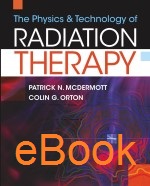
The Physics & Technology of Radiation Therapy
Author: Patrick McDermott and Colin OrtonISBN: 9781930524613
Published: 2010 | 856 pp | eBook
OUT OF PRINT
Medical Physics, 38(6) | June, 2011
Description
This is a book on the physics of radiation therapy that covers basic principles and new technologies in the field and how they apply to clinical practice. It is a well-referenced and easy to read text. It is a text designed as a parallel text or an alternative to well-established texts in the field of radiotherapy physics. In addition, the authors have made an extra effort to correlate the content of their text with the ABR for residents AART and MDCB board examinations physics requirements.
Purpose
The authors have successfully addressed the most common aspects of radiation physics from an educational and a practical perspective. They provide all the necessary information that is useful to radiation oncology residents, medical dosimetrists, and technology students. For individuals who are interested in further investigation, the reference list provided at the end of each chapter can assist a great deal.
Audience
This book is primarily directed toward the needs of radiation oncology residents since it has been developed through years of experienced teaching in residency programs, but in my opinion, it can also be useful to medical dosimetry and therapy technology students For practitioners in the field of radiotherapy, it can serve as a great supplemental resource for those who need to practice problem solving. I would strongly recommend the text to any radiation therapy technology training program, dosimetry program, and medical residency program in radiation oncology.
Content/Features
The contents of the book are laid out in 20 chapters and four appendices. All chapters include black and white graphs and figures to assist the reader. In the middle of the book, the authors have placed 40 color plates that correspond to figures already embedded in the text, which as a reader, I found to be very useful and well designed. There are numerous tables with data and information pertinent to the text that can be used in problem solving. There are calculated examples in almost every paragraph within a darker background that is noticeable to the reader and makes the topic more easily understood. Wherever possible, the authors have included “rule of thumb” tables that are designated by a thumb up symbol. I found those tables valuable for review and examination preparation. At the end of each chapter, the authors have presented a concise chapter of summary problems and a bibliography. The chapters start from traditional topics of radiation therapy physics and extend to new technologies and modalities. Wherever pertinent, the authors underline the importance of quality control, quality assurance, and patient safety. Appendix A outlines the physics topics required to be covered by the ABR board certification for radiation oncology, the AART board certification for radiologic technologists, and the MDCB certification for medical dosimetrists. Appendix B presents tabulated dosimetry data. Appendix C gives typical linac beam data called Mevelac beam data, by the authors, and Appendix D provides the answers to the problems in the text.
Chapters 1 and 2 cover basic mathematics and physics, in a review fashion. Chapters 3 through 6 cover atomic nuclei, radioactivity, x-ray production and technology, and interaction of radiation with matter. Since electron beams have been routinely used in radiotherapy and are an integral part of standard treatment modalities, they are covered in Chapter 15, along with their dosimetry. Chapters 7 and 8 describe radiation measurement and detection methods and systems. Chapters 9 through 12 cover linac technology, photon dosimetry, photon beam calibration, calculation of monitor units, and shaped photon fields. Chapters 14 through 16 present photon dose distribution methods of computations, electron beam dosimetry, and brachytherapy, which are the heart of clinical practice. Chapters 17 through 20 cover radiation protection, quality assurance, and patient safety, and all the new technologies from imaging in radiation therapy to special modalities and special procedures as well as their use in the clinical setting.
I found the text up-to-date and current with all the technologies and techniques that are seen today in radiotherapy physics and radiation oncology practice.
Assessment/Comparison
The text has a practical approach to the application of radiotherapy physics and planning that will primarily assists radiation therapy medical residents and technologists in building their background knowledge and understanding of why and how things happen in the clinical environment. For medical residents in radiation oncology, it can serve as a quick review “manual” that incorporates all the basic definitions and recent developments in the field. Without hesitation I recommend the text as a teaching tool for radiation therapy residencies and radiologic technology training programs.
Dimitris Mihailidis, Ph.D.
Charleston Radiation Therapy Consultants
Charleston, WV


